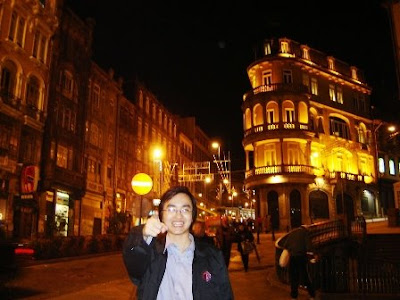(This story continue from Part 1 - Part 2 - Part 3 - Part 4 - Part 5 - Part 6 and Part 7)
**A TRIP TO OPORTO** (Cont.)
After visiting the Santa Maria da Vitória na Batalha (Batalha Monastery), the bus took off again, heading north. It took us a brief of time until we reached the Sanctuary of Fatima.
++Santuário de Fátima++
One hundred and forty-two kilometres (88 miles) North of Lisbon located Fátima, one of the most important shrines of the world dedicated to the Virgin Mary. This Sanctuary welcomes millions of pilgrims and tourists from all over the world. The fame of this place is the result of the Apparitions of 'Our Lady of the Rosary' to three shepherd children Lúcia and her cousins, Francisco and Jacinta that, between May and October of 1917, witnessed successive apparitions. The last one, on October 13th, was confirmed by a miracle witnessed by 70,000 people "on the day the sun danced". (source: PORTUGALVIRTUAL)
This sacred place is known as the most sacred in Portugal for the Virgin Mary. It was a bit sad for me since the rain again was fallen. I'm sure this place looks brighter and fairer in the full sunlight.
After a wet visit, the bus took off again, our company was heading north toward OPorto, the main city in the north of Portugal. Eventhough we took only one brief halt to find some refreshments, we arrived our hotel, Le Meridien Park Atlantic Porto, late and too tired to go out.
**OPORTO AT NIGHT**
I was spending 2 nights in Oporto, a city on the Rio Douro (Douro river), in the cosy hotel, Le Meridien Park Atlantic Porto. Our hotel was very nice eventhough there was no interesting place nearby. I had a chance to shoot some pictures on my first day training when our bus stopped. It was the nice pictures with the 'rabelos', the flat-bottom boats which was the vehicle used to transport 'PORT WINE' wine downriver from Vale do Douro (Douro valley), to be stored in barrels in cellars in Vila Nova de Gaia, just across the river from OPorto, one of the six bridges and the magnificent view of Oporto herself.
Later that night, and the last night in Oporto, I and Mr. Praphon agreed that, even though we were tired, we have to explore OPorto's city, by night was better than none. So, we leave the hotel, heading to the nearest Metro station (newly open) which took us around 20 minutes walk. After trying to understand how to use the system for a while, we took off to a station which we assumed to be the central part of the city.
I, somehow, was in a part of the city but I hardly noticed where I was. The Oporto @ night was quite peaceful; not many people walking to and fro. The air was chill but since I was walking continuously, I wasn't felt too cold. If you can recognise the place in the pictures, please let me know by commenting this post.
: a very beautiful scene of Oporto
: Mr. Praphon and golden leaves (My picture is blur -*-)
: Mapa da Cidade do Porto (Map of City of Porto)
Thus conclude my nights in Oporto. It was magnificent!!! However, I had to leave this beautiful scenic city and heading South-East to Coimbra. I wish I could come and visit Oporto once again.
THIS STORY CONTINUES IN PART 9






































